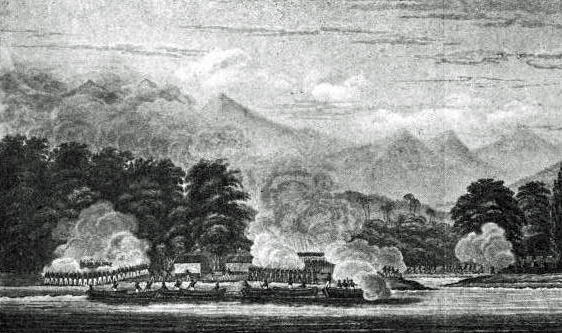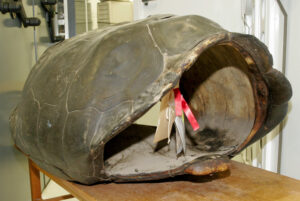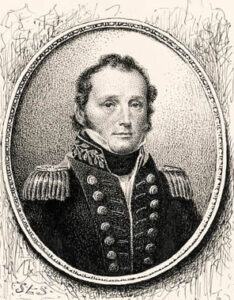Canton’s True Tales: Bombardment and Shells
By George T. ComeauThe USS Potomac embodied the spirit of a growing nation. The warship was built to establish a naval presence that would span the globe. And her first commander was a Canton-born man by the name of John Downes. As the commander over more than 500 men, a great weight was on the shoulders of this man. The imprint that Downes would leave on the Navy was indelible, and yet there is another side to his story that is only now being told 186 years later. The story involves two turtles.
Downes, a stern commander, had steadily risen up through the ranks. Ultimately, he would attain the title of commodore. This author had previously written a story about him in 2013. As is the case with history, new facts are always being discovered and with a man with as large an imprint as Downes, we learn more about him all the time. For without Downes, we may never have examples of a now extinct species of tortoises that left this earth at the hands of men by the 1840s.
The Potomac was based in New York City and her first trip as part of a Pacific Squadron started on August 19, 1832. The trip, which would last almost three years, was destined as an expedition of Sumatra. In fact, it was a trip designed to send a message across the globe that is still felt today in our modern conflicts. The message: Do not mess with the USA or we will hunt you down and exact retribution.
The island of Sumatra is renowned as an excellent source of pepper, and trade had been prosperous for many centuries. In 1831, the American merchant ship Friendship under the command of Captain Charles Endicott had arrived off the chiefdom of Quallah Battoo in order to secure a cargo of pepper. On the morning of February 7, 1831, Endicott and a few of his men went ashore to purchase some pepper from the natives when three small boats attacked his ship, murdered the first officer and two others of her crew, and plundered its cargo.
Endicott and the other surviving members of his crew managed to escape to another port with the assistance of a friendly native chief. With the help of three other captains, he was able to recover his vessel and would sail back to Salem, Massachusetts. Upon reaching Salem the public response was outrage and anger, and President Andrew Jackson crafted a response.
Commodore Downes had been ordered to provide passage to Martin Van Buren, the newly appointed minister to the Court of St. James. When news of the attack on the Friendship required a response, Secretary of the Navy Levi Woodbury ordered Downes to proceed to Sumatra by way of the Cape of Good Hope. At Quallah Battoo he was to make every effort to learn the true facts of the case and to punish the offenders.
Downes arrived in February 1832, at which point he received information that led him to believe that virtually the entire village of Quallah Battoo was involved in the Friendship incident and that the four forts on the island would put up a fight if attacked. In five hours, the forts were taken, reportedly with all 150 of the defenders, including the local chieftain, fighting to the death. Two days later, Downes shelled mercilessly the defenseless village and killed 300 more civilians. Downes was severely criticized for his actions, yet President Andrew Jackson supported him and in doing so sent a strong message to foreign governments — a message that can sometimes still resonate today.
The Pacific islands were no stranger to Downes. As a lieutenant in his early 20s he had served as executive officer for Captain David Porter aboard the Essex during her cruise in the Pacific in the War of 1812. In an action off James Island, Downes was in command of the sloop Georgiana during the capture of three British privateers. Downes also sailed to Nuku Hiva to assist in building America’s first military base in the Pacific. Downes knew the Galápagos Islands very well, specifically Floreana and all the surrounding islands.

The U.S. Infantry under the command of Cdre. John Downes assaulting the Acehnese forts at Quallah Battoo.
It was here that the turtles come into play, specifically the great and iconic tortoises that are so well tied to Darwin’s theory of evolution. Downes collected these ancient beasts and brought them back to Boston. What was a culinary delight was also a scientific marvel. The assistant surgeon on board the ship provided a medical report that noted, “A large number of the crew were daily on shore after terrapin, and frequently exposed to a hot sun with those immense animals on their backs, travelling over the broken lava…” There was some speculation that the men of the Potomac “brought down in one day 200 tortoises to the beach.”
In an account entitled the Cruise of the Potomac, the writer described the scene: “For we had unconsciously arrived upon the border of the terrapin region. I had well-nigh set my feet upon one of the crawling tribe. At length we seized our prizes, and placed them upon our backs, which was the easiest way of transporting them. These creatures are perfectly harmless, and weigh from one to three hundred pounds, so that one of ordinary size is a sufficient backload for a man, especially while performing a walk of five miles … One hundred terrapin, upon the bluff, of all sorts and sizes, some upon their backs and some in a crawling condition, made a ludicrous appearance; and occasioned no little trouble to the sailors, who sought to keep them within the due bounds of propriety. Finally, each was suspended by a rope and let down the bluff: All were placed within the boats, when we embarked and rowed safely back to the ship with our booty. Similar excursions were made during the two following days, till we finally had no less than six hundred terrapins on board, which were destined to furnish us with many a rich repast, during the remainder of our cruise.”
Downes would eventually circumnavigate the world, only the second U.S. Naval vessel (after the Vincennes) to successfully make the trip. The ship was also the first to host sitting royalty. Downes stopped at Hawaii and entertained that nation’s king and queen aboard his vessel on July 23, 1832.
Deep in the hold of the Potomac as she returned to Boston on May 23, 1834, were several giant tortoises. In particular, there were two that would be critical to the study of the new extinct species. Each of the animals weighed nearly 320 pounds. Soon after the arrival in Boston, the male died. But the female lived until the following winter. Both of the animals were donated to the Boston Society of Natural History — now the Museum of Science. In 1914 the remains of the two tortoises were transferred to Harvard University where they remain. Today, the relevance of the specimens collected by Downes are the subject of an obscure paper being considered for publication and written by Robert Rothman of Rochester Institute of Technology.

A modern photo of the tortoise at Harvard University, donated by Commodore Downes. (Dr. Robert Rothman, Thomas H. Gosnell School of Life Sciences, Rochester Institute of Technology)
Rothman called the local historical society when researching Downes, and had been focusing his paper on the two tortoises that Downes presented in 1834 in Boston. The two tortoises that Downes brought back to the United States are historically important to the scientific record of 19th century and the provenance of an extinct animal known as the Floreana tortoise.
Rothman acknowledges that his research is only of interest to a few people in the world. Yet, when he discusses the Downes specimens, it is as grand a discussion as an Arctic explorer would have when talking deep into the science behind the work. As Rothman explains, “My study appeals to a minute audience. I stumbled across this reference and looked at one paper about Galapagos animals and now we have DNA samples from the tortoise that Downes donated which had been attributed to have come from Floreana Island and was the first species to become extinct — from the first island to be colonized in the Galapagos chain.”
Rothman’s research took him to the Harvard Museum of Comparative Zoology and a firsthand look at the tortoises that Downes brought to Boston. Of the two that were donated in 1834, only the male is definitively located. The female may still be in a collection somewhere, but Rothman knows that the tag on what is purported to be the second animal is definitely a male and the original specimen is lost somewhere. The only other examples of this particular species were found in skeletons in lava caves and the species was extinct 10 years after Darwin’s trip to the region. The male specimen that has survived was studied over the years, and most recently in 2008 DNA studies proved that the animal came from Pinzón Island, and Rothman found a narrative of the voyage that suggests that Downes had collected tortoises from other nearby islands.
And so, our Canton native who traveled the world almost two centuries ago remains relevant today. Three ships in the United States Navy have been named USS Downes, yet perhaps his greatest contribution is that of a tortoise shell which is now in a cabinet in Cambridge, Massachusetts.
Special thanks to Dr. Robert Rothman, Thomas H. Gosnell School of Life Sciences, Rochester Institute of Technology.
Short URL: https://www.thecantoncitizen.com/?p=69757











